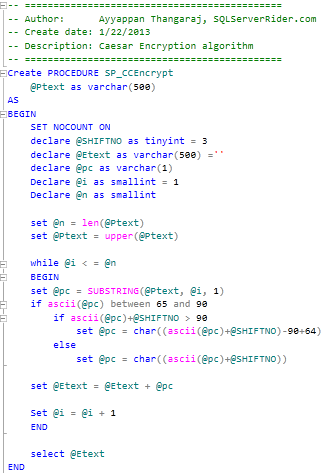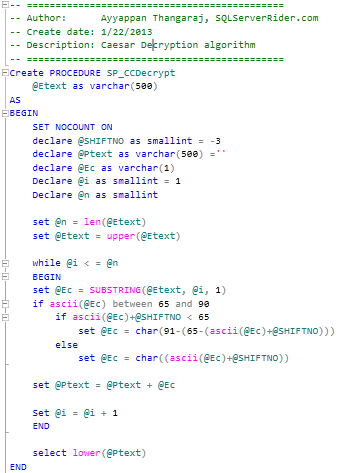In modern world, the cryptography has evolved drastically with mathematics, computer science, and electrical engineering. It help the encryption process more complex. So, It cannot (may be) broken by the third-party.
In this blog post, I am going to introduce two stored procedures that encrypt the plain text and other procedure decrypt the encrypted text. I am using caesar’s ciper technique. It is a type of substitution cipher in which each letter in the plaintext is replaced by a letter some fixed number of positions down the alphabet -Wikipedia.
Encryption Stored procedure: CCEncrypt

— =============================================
— Author: Ayyappan Thangaraj, SQLServerRider.com
— Create date: 1/22/2013
— Description: Caesar Encryption algorithm
— =============================================
Create PROCEDURE SP_CCEncrypt
@Ptext as varchar(500)
AS
BEGIN
SET NOCOUNT ON;
declare @SHIFTNO as tinyint = 3
declare @Etext as varchar(500) =”
declare @pc as varchar(1)
Declare @i as smallint = 1
Declare @n as smallint set @n = len(@Ptext)
set @Ptext = upper(@Ptext) while @i < = @n
BEGIN
set @pc = SUBSTRING(@Ptext, @i, 1)
if ascii(@pc) between 65 and 90
if ascii(@pc)+@SHIFTNO > 90
set @pc = char((ascii(@pc)+@SHIFTNO)-90+64)
else
set @pc = char((ascii(@pc)+@SHIFTNO)) set @Etext = @Etext + @pc Set @i = @i + 1
END select @Etext
END
GO Example:
 Decryption Stored Procedure: CCDecrypt
Decryption Stored Procedure: CCDecrypt — =============================================
— =============================================— Author: Ayyappan Thangaraj, SQLServerRider.com
— Create date: 1/22/2013
— Description: Caesar Decryption algorithm
— =============================================
Create PROCEDURE SP_CCDecrypt
@Etext as varchar(500)
AS
BEGIN
SET NOCOUNT ON
declare @SHIFTNO as smallint = -3
declare @Ptext as varchar(500) =”
declare @Ec as varchar(1)
Declare @i as smallint = 1
Declare @n as smallint set @n = len(@Etext)
set @Etext = upper(@Etext) while @i < = @n
BEGIN
set @Ec = SUBSTRING(@Etext, @i, 1)
if ascii(@Ec) between 65 and 90
if ascii(@Ec)+@SHIFTNO < 65
set @Ec = char(91-(65-(ascii(@Ec)+@SHIFTNO)))
else
set @Ec = char((ascii(@Ec)+@SHIFTNO)) set @Ptext = @Ptext + @Ec Set @i = @i + 1
END select lower(@Ptext)
END
GO Example:











No comments:
Post a Comment